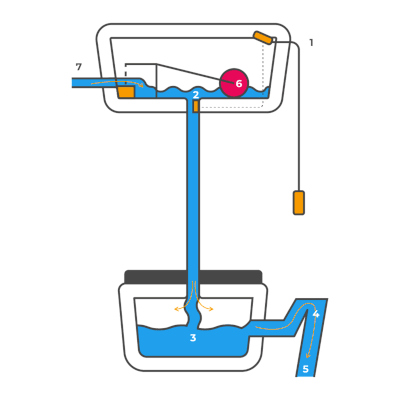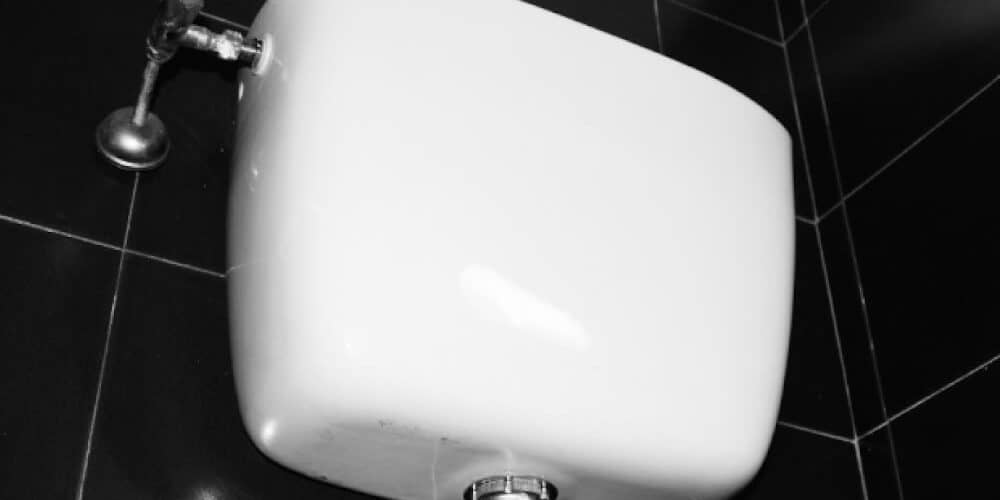Many beautiful bathrooms we have the privilege of working in, still boast a toilet with a high-level cistern mounted on the wall. These high-tank style toilets reigned bathrooms across the UK during the Victorian era and are still sought after by owners of period properties for their timeless appeal and subtle nod to the era in which their property originated. We are pretty sure that even The Queen herself still boasts high level toilets within many of her 78 bathrooms at Buckingham Palace, after all, the palace famously became the principal royal residence on the accession of Queen Victoria, and very little has been done to update the plumbing infrastructure at the palace since.
This article answers takes a closer look at high-level toilet cisterns and how they work.
What is a high-level toilet cistern?
A high-level toilet cistern refers to the traditional UK Victorian style “high-level” toilets whereby the cistern sits high up fixed to the wall with a very long, exposed flush pipe extending down and connecting to a low-level toilet pan. A long pull chain is used to flush.
Older plumbing systems relied on gravity, whereby the water pressure created by the fall from the high cistern to the bowl is needed to effectively flush the loo. Therefore, it was necessary to have tanks installed higher up on the bathroom wall.
How does a high-level cistern work?
The cistern is the small tank that appears behind you when seated on the toilet seat or above you if you have a high-level cistern type toilet. This compact tank stores cold water locally to the toilet. When we flush, the stored water gushes through the toilet pan, rinsing it clean and pushing the waste through the U-bend and on its way to the sewer. Once emptied, the toilet cistern will then fill up automatically, ready for the next time the flush chain is pulled.
To release the cold water stored in the toilet cistern, a flush control needs to be activated. This can be a lever, a push button or even a sensor (meaning you don’t have to physically touch the controls in order to operate it). Due to their height and traditional style, high level toilets typically boast long pull chains for flush control.
Let’s take a detailed look at exactly what happens inside the cistern and toilet when you operate the flush control…
- Pull the chain to flush the toilet which will operate a lever (dotted line) inside the cistern.
- The lever will open a valve (orange) that allows the cistern to empty into the toilet pan through a mechanism (siphon).
- Water will flow from the cistern down the flush pipe and through holes in the toilet rim to wash the bowl as well as flush waste away.
- The amount and force of the water flushes the toilet waste around the S-bend. This produces a siphon effect that draws out most of the liquid and the waste contents within it until the bowl is clean. A little bit of water remains in the bowl to improve hygiene.
- The waste contents from the toilet are then flushed down the main drain.
- As the cistern empties, the plastic float (in red) falls downwards and tilting a lever.
- The tilting lever opens the ball valve (orange) at the base of the cistern, to allow pressurised water to flow in to refill the cistern. As it refills the float returns to the top again back to its correct (pre-flush) position. At this point, the ball valve closes, and the water supply is unable to enter the cistern.
The toilet is now ready for the next user!

Do high level toilets flush better?
Because high level cistern loos originate from early flush toilet designs from as far back as the 1700s, many people assume that they will not flush as well as modern-day low-level toilets. In fact, this isn’t necessarily the case. As high-level cisterns are fixed to the wall at a high level, they have the added benefit of gravity and greater head pressure on their side which will help the water flush with more force.
However, how well a toilet flushes will depend on several factors, such as how much water there is in the cistern and the design of the toilet bowl – if designed well, the removal of the contents will be easier. Plus, modern cisterns typically use less water per flush, which is also a very important point to consider. To further minimise water consumption, you can apply Tips on Water Saving while Using Your Toilet for an eco-friendly approach.
Why have a high-level toilet?
Modern toilets no longer rely on gravity to flush effectively, so why are the still so popular among modern homeowners, I hear you ask? Well, it all comes down to style. Traditional high cistern toilets offer a classic, timeless style that continues to remain popular in today’s bathroom designs. Owners of Victorian and Georgian homes are particularly keen to keep as many original features of their property as they can (or replicate as closely as possible where retaining them is not an option). Keeping a period home authentic helps to retain its value and more importantly, retain the charming features that these dwellers fell in love with when they bought the property in the first place. If you're updating the bathroom, be sure to check the Essential Modern Bathroom Accessories selection guide to find the perfect additions. There are so many beautiful ranges of high-level toilets available on the market today that you will be spoilt for choice.
High level Vs low level toilets
As with anything, there are pros and cons to installing a high-level toilet:
Disadvantages of a high-level toilet
- Can be a little expensive, depending on what you opt for, but you should be able to find something that complies with your budget.
- Can be a challenge integrating into a smaller bathroom scheme or a bathroom with a low or sloped ceiling due to the cistern needing to be up high. However, there are different sizes available as well as angled flush pipes etc to help you find a work-around solution.
- They tend to use more water per flush compared to modern alternatives.
Advantages of a high-level toilet
- The make a stunning bathroom feature.
- They add charm and character to period homes and settings.
- They can be customised – beautiful and changeable chains, handles, and cistern brackets. Chrome or gold flush pipes, oak toilet seats, patterned cisterns – there are a wealth of possibilities.
- A powerful flush thanks to the added head pressure resulting from the cistern height.
If you are in need of a professional plumber to carry out any bathroom services in your property, we can help. Whether, you want to install a new soft close or rimless toilet, replace your shower for a snazzy digital version or you are looking to completely renovate your bathroom and need an experienced and approved plumber in London to carry out all aspects of the work involved, our team can provide all the assistance you require. We can even help you to design a new bathroom for your property, advising you on what is possible within your current layout and putting you in touch with experienced designers. Whether you need a certified local plumber in London or design assistance, get in touch for expert help with bathrooms of all sizes, no matter the challenge.

